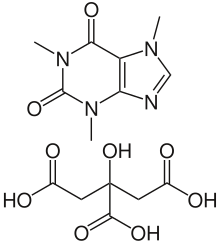Caffeine citrate
This article needs additional citations for verification. (September 2014) |
 | |
| Clinical data | |
|---|---|
| Trade names | Cafcit |
| AHFS/Drugs.com | Caffeine caffeine, Caffeine citrate Monograph |
| Routes of administration | Oral, i.v. |
| ATC code | |
| Identifiers | |
| |
| CAS Number | |
| PubChem CID | |
| ChemSpider | |
| CompTox Dashboard (EPA) | |
| ECHA InfoCard | 100.125.472 |
| Chemical and physical data | |
| Formula | C14H18N4O9 |
| Molar mass | 386.314 g/mol g·mol−1 |
| 3D model (JSmol) | |
| |
| |
| (verify) | |
Caffeine citrate (trade name Cafcit) is a citrate salt of caffeine, sometimes used in medical treatment, including short-term treatment of apnea of prematurity (lack of breathing in premature infants). Caffeine citrate functions in much the same capacity as does caffeine, but takes effect more quickly; its speed of dissociation is faster than that of caffeine. Like its sister compound, it can be used to dispel pain from a headache. However, caffeine sodium benzoate is typically only used to treat severe migraines, not the citrate form.
The drug is prepared simply by combining anhydrous caffeine with citric acid monohydrate and sodium citrate dihydrate. In method of action, the preparation is exactly identical to that of caffeine base as the citrate counter ion dissociates in water. Doses of caffeine citrate, due to the added weight of the citrate moiety, are understandably higher than with caffeine base, i.e., it takes a larger dose to get the same amount of caffeine. The ratio of therapeutic doses of caffeine base to its citrate salt is typically 1:2. It is therefore generally recommended that caffeine is prescribed in terms of caffeine base, and not caffeine citrate.
It is on the WHO Model List of Essential Medicines, a list of the most important medication needed in a basic health system.[1]
References
- ^ "WHO Model List of EssentialMedicines" (PDF). World Health Organization. October 2013. Retrieved 22 April 2014.
External links
- [1] in the NCI Metathesaurus
